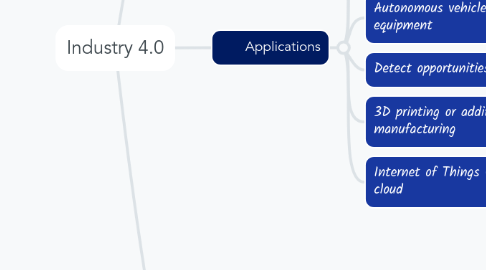
1. Definition
1.1. Is a transformation of the industry that is aimed at the automation, digitization and integration of all its processes
2. Pillars
2.1. Big Data
2.1.1. Is data that is presented in increasing volumes, at higher velocity and which contains a greated variety of information. This is known as "the three Vs"
2.1.1.1. The Three Vs
2.1.1.1.1. Volume
2.1.1.1.2. Velocity
2.1.1.1.3. Variety
2.2. Autonomous Robots
2.2.1. Those are the robots with the ability to execute actiities and task without the need of some kind of command or control given directly by the human being.
2.2.1.1. Kinds of Autonomous Robots
2.2.1.1.1. Service robots
2.2.1.1.2. Space exploration robots
2.2.1.1.3. Autonomous robots for people with disabilities
2.2.1.1.4. Rescue and emergency robots
2.2.1.1.5. Industrial robots
2.2.1.2. Applications
2.2.1.2.1. Military sector
2.2.1.2.2. Medical sector
2.2.1.2.3. Cars and services sector
2.2.1.2.4. Space sector
2.2.1.2.5. Industrial sector
2.3. Cybersecurity
2.3.1. Computer security
2.4. 3D Printing
2.4.1. Allows you to print three-dimensional solid objects no longer only on paper
2.5. Internet of Things
2.5.1. Is a digital interconnection network between devices, it detect patterns, makes recommendations and create new and better experiences for the user
2.6. Simulation
2.6.1. Is the representation of something or action that imitates what happens in reality.
2.7. Augmented Reality
2.7.1. It is like an enhancement of real-world information through electronic devices, it adds digital information to a real-world image through the camera of electronic devices.
2.8. Cloud Computing
2.8.1. Is a storage computing services,, that is, the user's computer should no longer have all the programs, software and data installed or saved.
2.9. Integration Systems
2.9.1. Allow the various platforms and company systems to connect with each other, sharing information and functioning as a single platform
